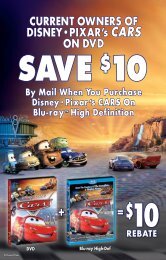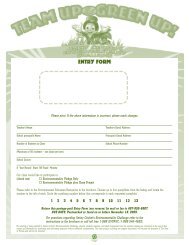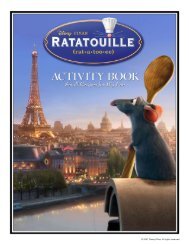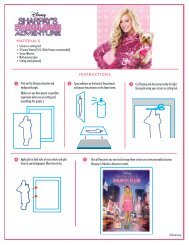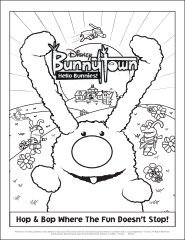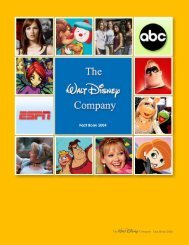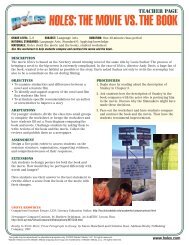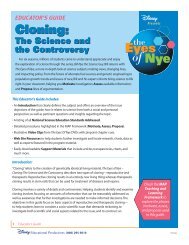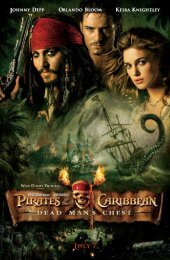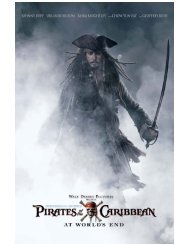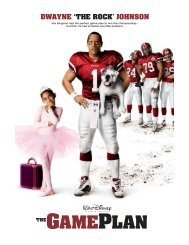1 CARS PRODUCTION INFORMATION After taking ... - Disney
1 CARS PRODUCTION INFORMATION After taking ... - Disney
1 CARS PRODUCTION INFORMATION After taking ... - Disney
Create successful ePaper yourself
Turn your PDF publications into a flip-book with our unique Google optimized e-Paper software.
to hear these great stories first-hand from a person whose family had been there<br />
for generations.”<br />
Associate producer Tom Porter recalls, “When John and his team came<br />
back from their Route 66 trip, there was a lot of talk about wanting to capture<br />
the patina of the Southwest. They wanted everything in the film to be shaded so<br />
that it had the authenticity of that old 40s, 50s, 60s stuff that was faded and<br />
weathered after fifty years. John wanted the full complexity of a Southwestern<br />
town looking authentic, and then a similar set of challenges in the racing world.”<br />
Bill Cone, the production designer who was responsible for creating the<br />
look of the film’s environments and building a five-mile stretch of road that leads<br />
in and out of the town of Radiator Springs, recalls, “I think of the style for this<br />
film as cartoon realism. You have talking cars, so you’ve already taken a step<br />
away from reality in that regard. The forms are a little whimsical. You’ll see<br />
these car shapes on the cliffs, and the clouds are stylized. I reached the<br />
conclusion that humans in a human universe would see their own forms in<br />
nature, which they often do. They name things like Indian Head Rock. So, in a<br />
car universe, they would have car-based metaphors for forms. Suddenly, you<br />
could see these cliffs that looked very much like the hoods of cars, or an<br />
ornament. Great American artists like Maynard Dixon also had a big influence<br />
on us with their landscapes of the Southwest and the clouds that they painted.”<br />
Sophie Vincelette, sets supervisor for the film, was responsible for<br />
creating the film’s mountain range that pays homage to the famous Cadillacs<br />
planted in the ground along Route 66. Other mountains are shaped like<br />
wheelwells, and bumpers.<br />
In every aspect, “<strong>CARS</strong>” represents a new level of attention to detail for<br />
Pixar. With its crumbly bits of concrete, accumulated dust, and layers of faded<br />
advertisements painted on brick walls, Radiator Springs feels like a real place<br />
audiences could visit.<br />
According to Vincelette, “Our challenge was to give the buildings in town<br />
the appearance of having a sense of history. We worked closely with the<br />
shading and modeling teams to give them a weathered look, and to make sure<br />
that things were not always straight. There are weeds growing out of cracks in<br />
the cement on the sidewalk.”<br />
Adding to the authenticity of the desert location, modelers in the Sets<br />
department were able to dot the landscape with thousands of pieces of<br />
vegetation, including cactus, sagebrush (in brown, green, yellow and tan<br />
varieties), and grass. Rocks of varying formations also added interest to the<br />
scenery.<br />
To ensure authenticity in their car designs, the production design team<br />
conducted research at auto shows, spent time in Detroit with auto designers and<br />
manufacturers, went to car races, and made extensive studies of car materials.<br />
“Research is a big thing for John,” says Pauley. “It’s also the most fun<br />
part of the job because we got to go to car shows and races, and other neat stuff.<br />
One of the things we did was to visit Manuel’s Body Shop right near the Studio.<br />
He gave us a lot of detail and helped us understand how they apply layers and<br />
coats of paint on a car.”<br />
14



